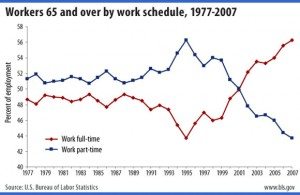
A healthy workforce will contribute higher productivity and fewer workdays lost to illness or injury. Healthy, thriving businesses with healthy, thriving workforces are the key to getting our economy back on its feet. And more of them are older than ever.
The Importance Of A Healthy, Older Workforce
By Bonnie Guith
Because of this, exercise needs to be an important part of our everyday life. As we age there are a number of chronic conditions and problems that can be prevented or decreased. A woman who walks at least an hour per day has a 40% lower risk of a stroke than one who walks less than an hour a week.
Broken bones can be avoided by aerobic and strength training exercises three to five days a week. Moderately active people have a 30 to 40 % lower risk of developing Type 2 Diabetes and metabolic syndrome than inactive people. Depression also decreases 15% to 25% in active people.
 For those who are currently depressed, moderate to vigorous aerobic exercise for 30 minutes three times per week can improve symptoms. (Bonnie Liebman, NutritionAction, December 2005, Nine Other Reasons to Exercise.) The list goes on and on for why exercise is important to our wellbeing.
For those who are currently depressed, moderate to vigorous aerobic exercise for 30 minutes three times per week can improve symptoms. (Bonnie Liebman, NutritionAction, December 2005, Nine Other Reasons to Exercise.) The list goes on and on for why exercise is important to our wellbeing.
Finding the time to exercise regularly may seem nearly impossible with a busy work schedule. If carving out time before or after work isn’t feasible, exercising during your lunch break may be your best bet. Find a route near work you can walk at least 20 to 30 minutes each day.
If you don’t have time to get moving outdoors, consider doing stretches in your office. Do exercises like toe touches or windmill swings with your arms. If time permits, lunch-time aerobic classes are available. And yoga stretches are a great way to not only stretch for 30 minutes so, but your lunch hour can also help you forget about the stressors of the day.

©The Economist
Harley-Davidson’s Motorcycle Engine plant in Menomonee Falls, Wisconsin has an on-site gym with trainers who create customized exercise routines based on an individual’s job. Employees are encouraged to report any pain or injury and ice packs are available at shift change.
A healthy workforce will contribute to a healthy bottom-line for businesses and the economy as a whole. When workers stay safe and healthy, businesses have reduced medical insurance and worker’s compensation costs. They can also count on higher productivity and fewer workdays lost to illness or injury. Healthy, thriving businesses with healthy, thriving workforces are the key to getting our economy back on its feet.
Bonnie is a guest blogger to HRB — Bonnie Guith Is a gerontological nurse practitioner. She has practiced in the field for over 15 years in southeastern michigan. She holds a bachelors of science from Nazareth College as well as a master’s of science in nursing from the University of Michigan and is certified as a gerontological nurse practitioner.


Leave a Reply